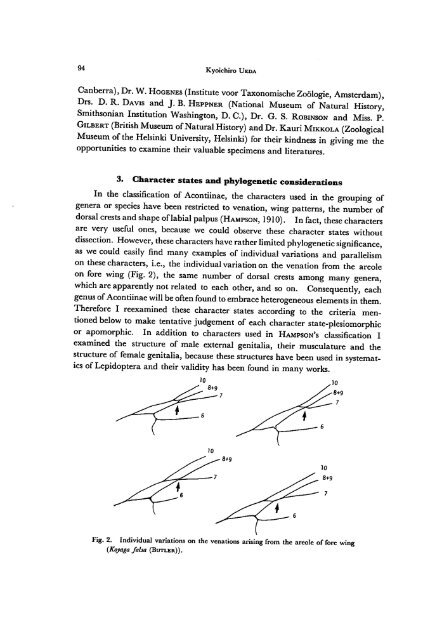A revision of the genus Deltote RL and its allied genera from Japan ...
A revision of the genus Deltote RL and its allied genera from Japan ...
A revision of the genus Deltote RL and its allied genera from Japan ...
Create successful ePaper yourself
Turn your PDF publications into a flip-book with our unique Google optimized e-Paper software.
94 Kyoichiro Ueda<br />
Canberra), Dr. W. Hogenes (Institute voor Taxonomische Zoologie, Amsterdam),<br />
Drs. D. R. Davis <strong>and</strong> J. B. Heppner (National Museum <strong>of</strong> Natural History,<br />
Smithsonian Institution Washington, D. C), Dr. G. S. Robinson <strong>and</strong> Miss. R<br />
Gilbert (British Museum <strong>of</strong> Natural History) <strong>and</strong> Dr. Kauri Mikkola (Zoological<br />
Museum <strong>of</strong> <strong>the</strong> Helsinki University, Helsinki) for <strong>the</strong>ir kindness in giving me <strong>the</strong><br />
opportunities to examine <strong>the</strong>ir valuable specimens <strong>and</strong> literatures.<br />
3. Character states <strong>and</strong> phylogenetic considerations<br />
In <strong>the</strong> classification <strong>of</strong> Acontiinae, <strong>the</strong> characters used in <strong>the</strong> grouping <strong>of</strong><br />
<strong>genera</strong> or species have been restricted to venation, wing patterns, <strong>the</strong> number <strong>of</strong><br />
dorsal crests <strong>and</strong> shape <strong>of</strong>labial palpus (Hampson, 1910). Infact, <strong>the</strong>se characters<br />
are very useful ones, because we could observe <strong>the</strong>se character states without<br />
dissection. However, <strong>the</strong>se characters have ra<strong>the</strong>r limited phylogenetic significance,<br />
as we could easily find many examples <strong>of</strong> individual variations <strong>and</strong> parallelism<br />
on <strong>the</strong>se characters, i.e., <strong>the</strong> individual variation on <strong>the</strong> venation <strong>from</strong> <strong>the</strong> areole<br />
on fore wing (Fig. 2), <strong>the</strong> same number <strong>of</strong> dorsal crests among many <strong>genera</strong>,<br />
which are apparently not related to each o<strong>the</strong>r, <strong>and</strong> so on. Consequently, each<br />
<strong>genus</strong> <strong>of</strong>Acontiinae will be <strong>of</strong>ten found to embrace heterogeneous elements in<strong>the</strong>m.<br />
Therefore I reexamined <strong>the</strong>se character states according to <strong>the</strong> criteria men<br />
tioned below to make tentative judgement <strong>of</strong> each character state-plesiomorphic<br />
or apomorphic. In addition to characters used in Hampson's classification I<br />
examined <strong>the</strong> structure <strong>of</strong> male external genitalia, <strong>the</strong>ir musculature <strong>and</strong> <strong>the</strong><br />
structure <strong>of</strong>female genitalia, because <strong>the</strong>se structures have been used in systematics<br />
<strong>of</strong>Lepidoptera <strong>and</strong> <strong>the</strong>ir validity has been found in many works.<br />
Fig. 2.<br />
Individual variations on <strong>the</strong> venations arising <strong>from</strong> <strong>the</strong> areole <strong>of</strong>fore wing<br />
{Koyaga falsa (Butler)).
















